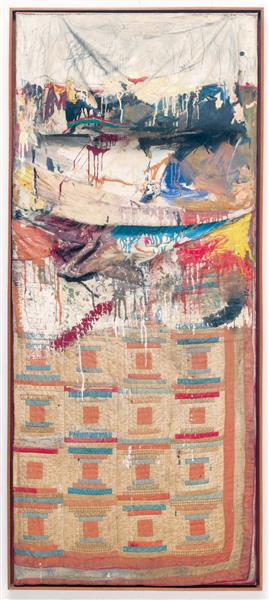Robert Rauschenberg was an American artist who made significant contributions to the development of pop art and assemblage art. One of his most renowned and controversial works is his “Bed” painting, created in 1955.
Rauschenberg’s “Bed” is a mixed-media artwork that blurs the boundaries between painting and sculpture. The piece consists of an actual bed, complete with a pillow, sheets, and a blanket, which is mounted on the wall vertically. The surface of the bed is heavily worked upon, covered in layers of paint, scribbles, and various materials.

Bed, 1955, Museum of Modern Art (MoMA), New York City, NY, US
At first glance, the “Bed” appears chaotic and messy, with its worn-out and stained sheets and the aggressive brushstrokes and markings. However, the piece carries a profound conceptual and symbolic significance. Rauschenberg’s “Bed” challenges conventional notions of art, pushing the boundaries of what can be considered a painting and redefining the materials and subject matter that can be used in artistic expression.
The bed, as a readymade object, holds personal and intimate connotations. By elevating the bed to the status of an artwork, Rauschenberg blurs the line between the private and the public, turning the personal into a public statement. The use of an actual bed, with its associations of sleep, dreams, and intimate spaces, introduces a deeply personal and autobiographical element into the artwork.
The layers of paint, scribbles, and materials applied to the bed’s surface convey a sense of emotional intensity and spontaneity. Rauschenberg’s use of these elements can be seen as a response to the abstract expressionist movement that dominated the art scene at the time. By incorporating a variety of materials and techniques, Rauschenberg challenged the idea of the artist’s hand as the sole creator and disrupted the notion of a singular artistic style.
The “Bed” painting also raises questions about the nature of art and the role of the viewer. Rauschenberg’s inclusion of a real bed challenges the traditional separation between art and life, inviting the viewer to reconsider their perception of art objects and their relationship to everyday objects. The viewer is prompted to question what constitutes art, what can be considered valuable or worthy of artistic exploration, and how personal experiences and emotions can be expressed through artistic means.
Rauschenberg’s “Bed” painting generated controversy and sparked debates about the boundaries of art and the role of the artist. Some critics and viewers found the work challenging and revolutionary, appreciating its innovative approach and conceptual depth. Others criticized it for its unconventional materials and its departure from traditional artistic techniques.
Nonetheless, the “Bed” painting remains an iconic and influential artwork that pushed the boundaries of artistic expression. It exemplifies Rauschenberg’s willingness to experiment with materials, challenge artistic conventions, and explore the intersections between art and life. The work continues to inspire and provoke discussions about the nature of art, the role of the artist, and the relationship between personal experiences and creative expression.
